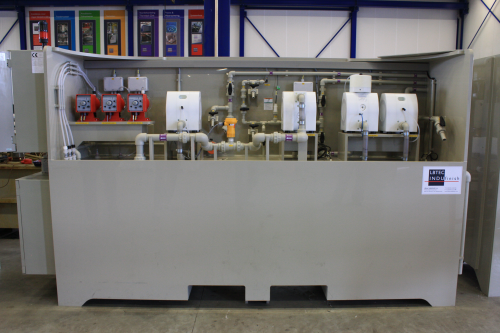
The process that is used to manufacture steel can be an extremely delicate one, part of the pre-treatment process involves very corrosive fluids like hydrochloric acid and flux fluids; any pump that used will need to last at least 10 years. One steel manufacturer found the solution in solid-body plastic air-operated double-diaphragm (AODD) pumps – which after six year of use, were found to be in perfect condition.
Most people are aware that steel possesses the strength and structural reliability to support a 100-story skyscraper or a mile-long extension bridge. What they may be unaware of, though, is the fact that despite its overall robustness and strength, the process that is used to manufacture steel can be an extremely delicate one.
One person who is intimately familiar with the intricacies of the steel-making process is Wim Brandsema. Brandsema is Director and 50% owner of LBTEC INDUfinish, Emmen, The Netherlands. Founded in 1991, the company specializes in creating and supplying complete systems that are used in surface-treating steel, particularly pre-treatment applications in the hot-dip galvanizing process. The company uses 3-D computer-modeling technology to create complete systems that specifically follow the direction of the client for design and operation.
“We are currently selling our equipment mainly throughout Europe and we are starting to pick up business in Northern Africa and the Middle East. We would also like to grow our business in South and North America,” said Brandsema. “Lbtec Indufinish is very specialized in hot-dip galvanizing, particularly the pre-treatment stage of the hot-dip galvanizing process.”
Pre-treatment
The pre-treatment stage that leads to the actual hot-dip galvanizing of steel is a very precise and exacting one:
- A piece of raw steel is pre-treated with a degreaser to remove any oil and grease from its surface.
- Then the steel is ‘pickled’ in a hydrochloric acid bath.
- After pickling, the steel is dipped in flux fluid; the flux fluid ensures that the zinc will react correctly with the steel.
- The steel is then placed in a melted zinc bath with a temperature of 450ºC (842ºF); if the previous three steps are not followed properly, the zinc will not adhere to the raw steel, resulting in a substandard product.
- After receiving its hot-zinc bath, the piece of steel is hot-dip galvanized.
What the steel manufacturer has done is create a system that houses the flux fluid that is used in the pre-treatment process. The system consists of four compartments: the first contains the flux fluid; the second mixes the flux fluid with certain chemicals to obtain the correct pH level; the third receives the flux fluid after it has passed through a filter press that makes sure that any iron in the flux fluid is collected so that only clean flux fluid comes out; and the fourth gathers the used flux fluid before it is transferred to the flux-cleaning unit and back to the first flux-fluid tank. The heartbeat of the system is the four individual pumps that keep the flux fluid flowing flawlessly between the four compartments.
“We began producing these units in 2006 and the most important issue is that you have to make sure it is not going to be corroded when operated,” said Brandsema. “Flux fluid is very aggressive so we have to have a pump that that will last at least 10 years. We knew that to manufacture our products we would need plastic pumps that would have to deal with very corrosive fluids like hydrochloric acid. Steel, carbon steel and stainless steel aren’t compatible with these very aggressive fluids, so you need plastics like PE, PP, PVCs and PVDF.”
Flux-fluid systems
When the steel manufacturer began creating its flux-fluid systems it was searching for the perfect pump to control the process. Too often, the technology that was chosen for the second stage of the process—where the chemical solution was being introduced to the flux fluid for pH control—was falling short in its ability to meet the system’s needs.
“When we first built this system in 2006, we started off with an electric-driven, vertical centrifugal pump for the second stage, but it lasted only six months,” said Erik van der Staaij, sales manager for Lbtec Indufinish. “At that point, the engine was rotted away by the chemistry we were pumping, so we needed a very corrosion-resistant solution.”
A full version of this article will soon appear in World Pumps magazine.
The digital edition of the magazine is distributed free of charge to readers who meet our qualifying criteria. You can apply to receive your free copy by completing this short registration form



